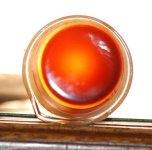In my research for articles included in our new blog site launch, I found errors in my previous understanding of what was being extracted in cannabis essential oils, because we aren't typically testing for them.
Not only was I mildly embarrassed by finding out I’ve repeatedly misspelled the word anthocyanin as anthrocyannin on multiple forums around the world, but deeply embarrassed to learn I ’de accepted some things at face value without adequate vetting, and thus missed some important clues as to where all the color comes from in a cannabis essential oil extraction.
We are extracting a range of molecules starting with the C-10 monoterpenes, some with accompanying C-5 fractions, through C-55 Chlorophyll and Pheophytin.
To better understand where we are picking up color, let’s look at their individual colors and nature.
For the most part the monoterpenes are colorless, but when we reach the C-15 Sesqui-terpenes we find some color and that is also where we find the water soluble anthocyanin color pigments/glucosides/flavonoids, which have vivid colors.
The C-21 &22 Cannabinoids range from white to light yellow, so don’t add much color, and the about ~C-30 plant waxes are light beige, which serves to cloud and occlude light as opposed to adding to the brown.
Here we come to some powerful color sources, starting with non polar C-40 beta Carotene, which is yellow to red in color, the fall colors that emblazon Ma Nature in the fall.
Followed by polar C-55 Chlorophyll which is vivid green, and not attractive to non polar LPG, but its byproduct of decomposition non polar Pheophytin, which is olive brown, is attractive to non polar solvents like LPG.
Sooo, the last paragraph explains in part why older material non polar LPG extractions are darker, because they do readily extract non polar pheophytin, even though they didn’t much polar chlorophyll.
The water solubility of the C-15 anthocyanin/glucosides/flavonoids also explains how freezing ties them up and minimizes their extraction, as well as why polar miscible alcohol is more effective extracting them.
Up to this point we haven’t discussed beta Carotene, but no new news on why -30 to -70C reduces its extraction rate, thus lightening the extraction.
Also no new news on why subzero reduces polar chlorophyll pickup, as when water is present, it is tied up in ice. The same would be true of non-polar Pheophytin if water is still present, but consider what there is keeping the non-polar solvent away from the non-polar Pheophytin once the material is fully desiccated, so that there is no ice regardless of the low temperature.
That suggests that rehydrating the material some before freezing it may prove beneficial, so we will be following up with that experiment and expanding on it more both here and in our TAR blog site.
Not only was I mildly embarrassed by finding out I’ve repeatedly misspelled the word anthocyanin as anthrocyannin on multiple forums around the world, but deeply embarrassed to learn I ’de accepted some things at face value without adequate vetting, and thus missed some important clues as to where all the color comes from in a cannabis essential oil extraction.
We are extracting a range of molecules starting with the C-10 monoterpenes, some with accompanying C-5 fractions, through C-55 Chlorophyll and Pheophytin.
To better understand where we are picking up color, let’s look at their individual colors and nature.
For the most part the monoterpenes are colorless, but when we reach the C-15 Sesqui-terpenes we find some color and that is also where we find the water soluble anthocyanin color pigments/glucosides/flavonoids, which have vivid colors.
The C-21 &22 Cannabinoids range from white to light yellow, so don’t add much color, and the about ~C-30 plant waxes are light beige, which serves to cloud and occlude light as opposed to adding to the brown.
Here we come to some powerful color sources, starting with non polar C-40 beta Carotene, which is yellow to red in color, the fall colors that emblazon Ma Nature in the fall.
Followed by polar C-55 Chlorophyll which is vivid green, and not attractive to non polar LPG, but its byproduct of decomposition non polar Pheophytin, which is olive brown, is attractive to non polar solvents like LPG.
Sooo, the last paragraph explains in part why older material non polar LPG extractions are darker, because they do readily extract non polar pheophytin, even though they didn’t much polar chlorophyll.
The water solubility of the C-15 anthocyanin/glucosides/flavonoids also explains how freezing ties them up and minimizes their extraction, as well as why polar miscible alcohol is more effective extracting them.
Up to this point we haven’t discussed beta Carotene, but no new news on why -30 to -70C reduces its extraction rate, thus lightening the extraction.
Also no new news on why subzero reduces polar chlorophyll pickup, as when water is present, it is tied up in ice. The same would be true of non-polar Pheophytin if water is still present, but consider what there is keeping the non-polar solvent away from the non-polar Pheophytin once the material is fully desiccated, so that there is no ice regardless of the low temperature.
That suggests that rehydrating the material some before freezing it may prove beneficial, so we will be following up with that experiment and expanding on it more both here and in our TAR blog site.



